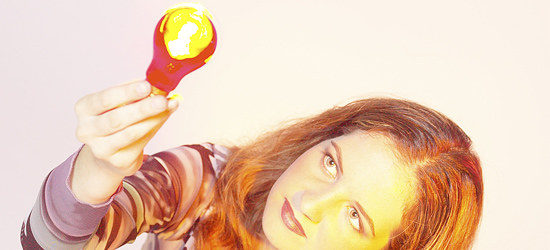Lighting plays a much greater part in our productivity than most people realize. There is quite a bit of research that supports the idea that productivity increases along with the amount of light in your workspace (at least up to a certain point).
However, if the increase produces glare, it is counter-productive. This is especially true for people working in front of a computer. The best lighting solution is one where the lighting is indirectly bounced off the ceiling. This helps diffuse the light and cuts down on the amount of glare. Some of the best lamps I’ve used are the halogen floor lamps that shine their light all on the ceiling.
Another thing to consider in lighting your workplace is the spectrum of the light. Different light bulbs give off light in different parts of the spectrum. Ideally, you want light that is as close as possible to sun light. In the past, florescent bulbs have not been very good at this. I once attended a university where the communications department had specifically put in incandescent bulbs in their classroom areas because they felt that the florescent light was distracting. There are modern florescent bulbs that cover a very wide spectrum. They are more expensive, but the cost is often more than offset by increased productivity.
A final area to consider is the impact of the seasons on your lighting. Areas that are well lighted in the summer may be less than adequate during the darker winter months. If you feel like you are hitting something of a winter slump, the remedy may be as simple as turning on some additional lights.
Originally published on November 16, 2005.

Lighting plays such an important role in our day to day health and well being. Try setting a lamp behind you, or off to the side, where the illumination from the light source lights up your area, where you need to see, but doesn’t glare at you at all.
You’ll notice a world of difference in your attitude towards life and a reduction in your irritability.
Interesting article. I’ve known lighting has always been crucial to setting the mood which is why cinematographers and professional photographers are over paid. I guess I never thought they have an effects on one’s productivity. And that’s a good trick with the indirect lighting. I always thought they do that because it looks better and more stylish. I guess it has more practical uses.
Great post! I recently attempted to slay the lighting dragon myself. Personally, I cannot stand fluorescent light and find it somewhat depressing. It was especially bad when I had an office with no window. I noticed that you talk about the spectrum of light which I found to be key for me as well. I added an incandescent lamp with really no difference. Then I switched that out for a 300w halogen which I thought could light the whole room on its own. Turns out it could not but it did change the frequency of the light to a much warmer and less harsh presence. Now I have a window which is great (nothing beats natural light). However, one days, like today, where it is overcast I still use the halogen.
Thanks for the post. I think this is a great topic for productivity.
Check out this Wikipedia link to the Hawthorne Effect based on lighting experiments in factories.
http://en.wikipedia.org/wiki/Hawthorne_effect
Brian
Brian – There are some new tube bulbs that replace fluorescent lights that you might check into. They come in different spectrums and should last for a very long time–plus there is no buzz and virtually no heat.
I agree. Nothing beats natural light.
I actually agree with this post completely. Over the past few days, I’ve been using a laptop rather than a desktop, which has given me the freedom to get outside and get my work done in a much better lit place, and I have felt the difference not only in terms of productivity, but also in terms of stress levels. When I’m outside, getting stuff done on my laptop, I instantly feel much more relaxed and much less worried.
Lighting plays an important part in all our activities, and there are a lot of cost-efficient and eco-friendly options in the market too.